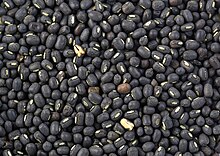| Vigna mungo | |
|---|---|

| |
| Dry urad beans | |
| Scientific classification | |
| Kingdom: | Plantae |
| Clade: | Tracheophytes |
| Clade: | Angiosperms |
| Clade: | Eudicots |
| Clade: | Rosids |
| Order: | Fabales |
| Family: | Fabaceae |
| Subfamily: | Faboideae |
| Genus: | Vigna |
| Species: | V. mungo
|
| Binomial name | |
| Vigna mungo | |
| Synonyms[1] | |
| |
Urad bean or black gram[a] (Vigna mungo) is a bean grown in South Asia. Like its relative, the mung bean, it has been reclassified from the Phaseolus to the Vigna genus. The product sold as black gram is usually the whole urad bean, whereas the split bean (the interior being white) is called white lentil. It should not be confused with the much smaller true black lentil (Lens culinaris).
Black gram originated in South Asia, where it has been in cultivation from ancient times and is one of the most highly prized pulses of India. It is very widely used in Indian cuisine. In India the black gram is one of the important pulses grown in both Kharif and Rabi seasons. This crop is extensively grown in the southern part of India and the northern part of Bangladesh and Nepal. In Bangladesh and Nepal it is known as mash daal. It is a popular daal (legume) side dish in South Asia that goes with curry and rice as a platter. Black gram has also been introduced to other tropical areas such as the Caribbean, Fiji, Mauritius, Myanmar and Africa mainly by Indian immigrants during the Indian indenture system.
- ^ "The Plant List: A Working List of All Plant Species". Archived from the original on 17 November 2018. Retrieved 14 December 2014.
Cite error: There are <ref group=lower-alpha> tags or {{efn}} templates on this page, but the references will not show without a {{reflist|group=lower-alpha}} template or {{notelist}} template (see the help page).